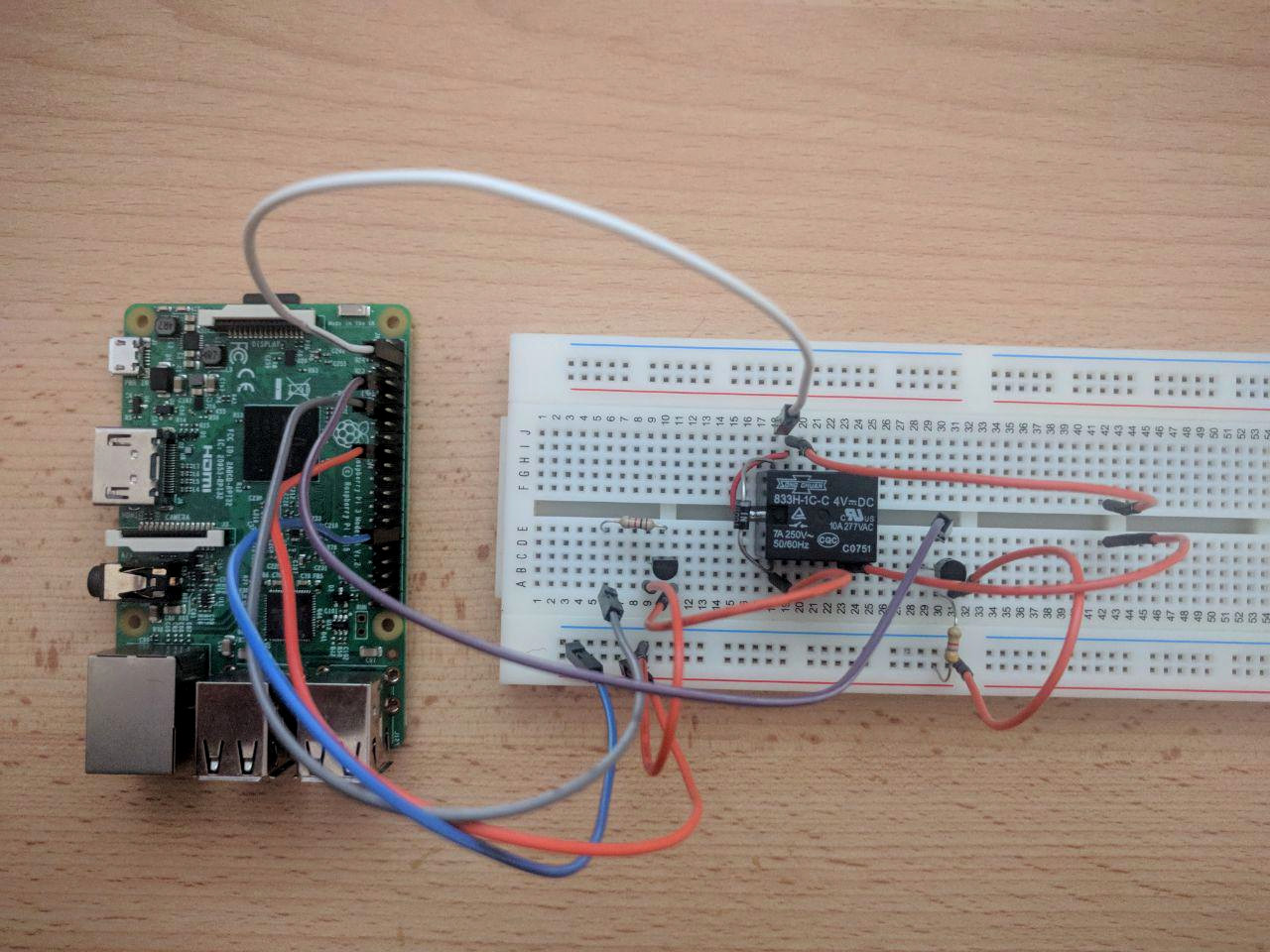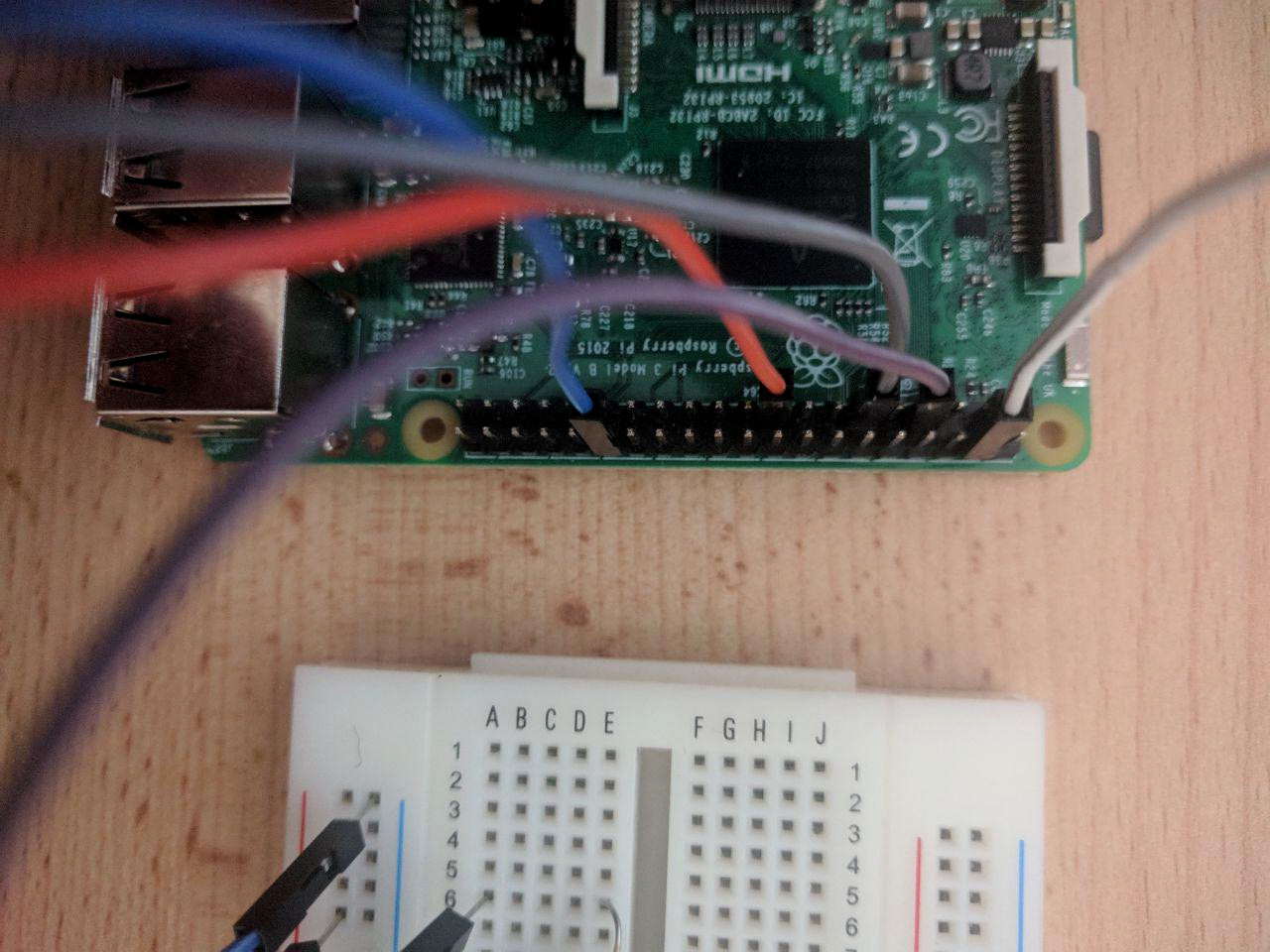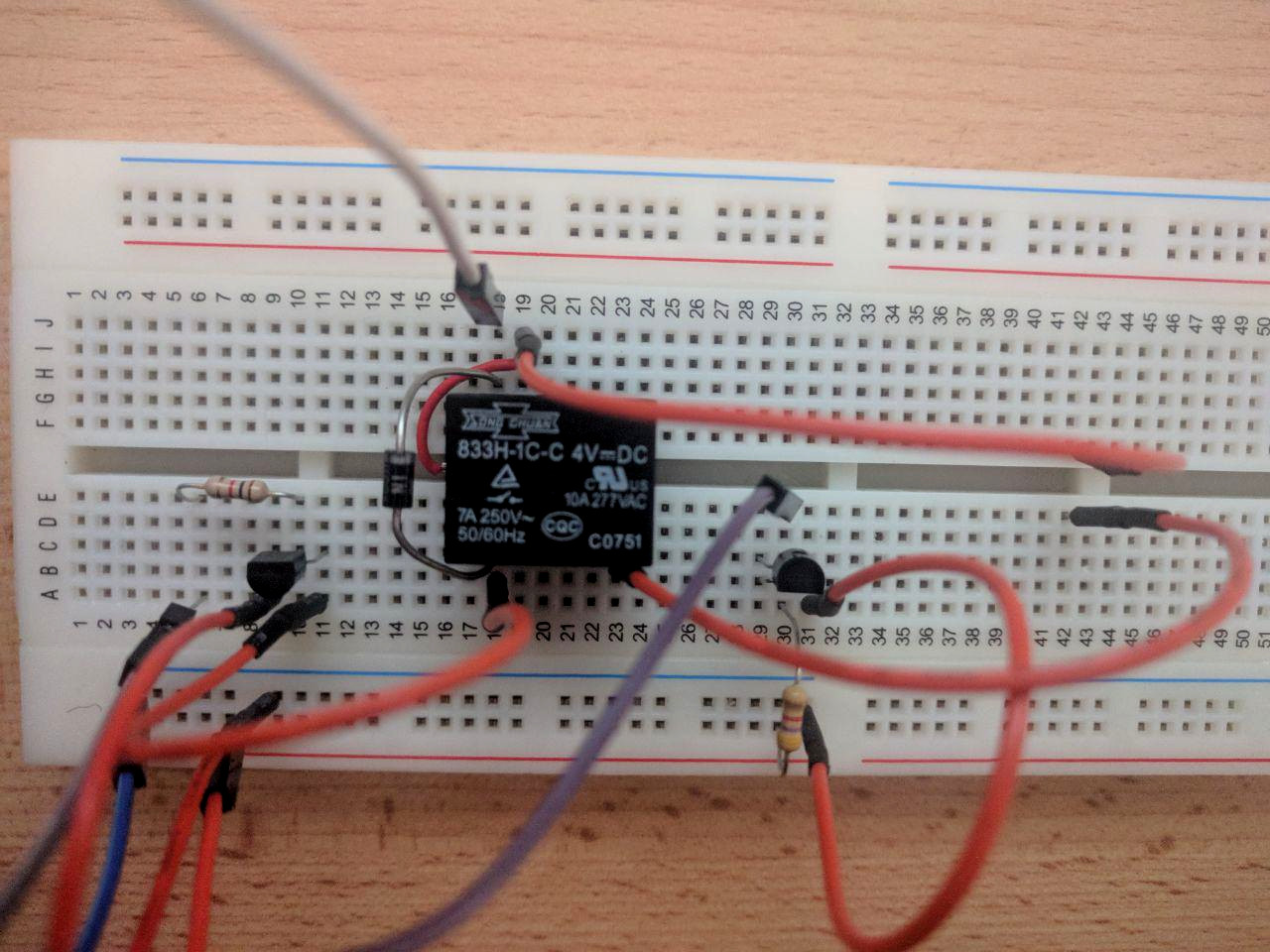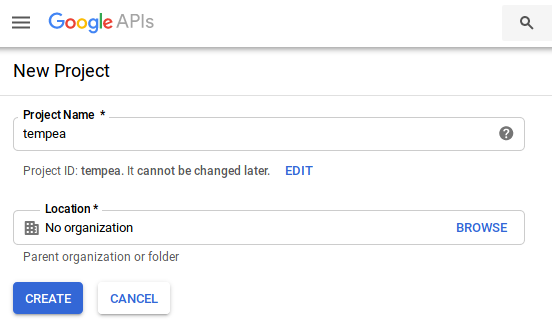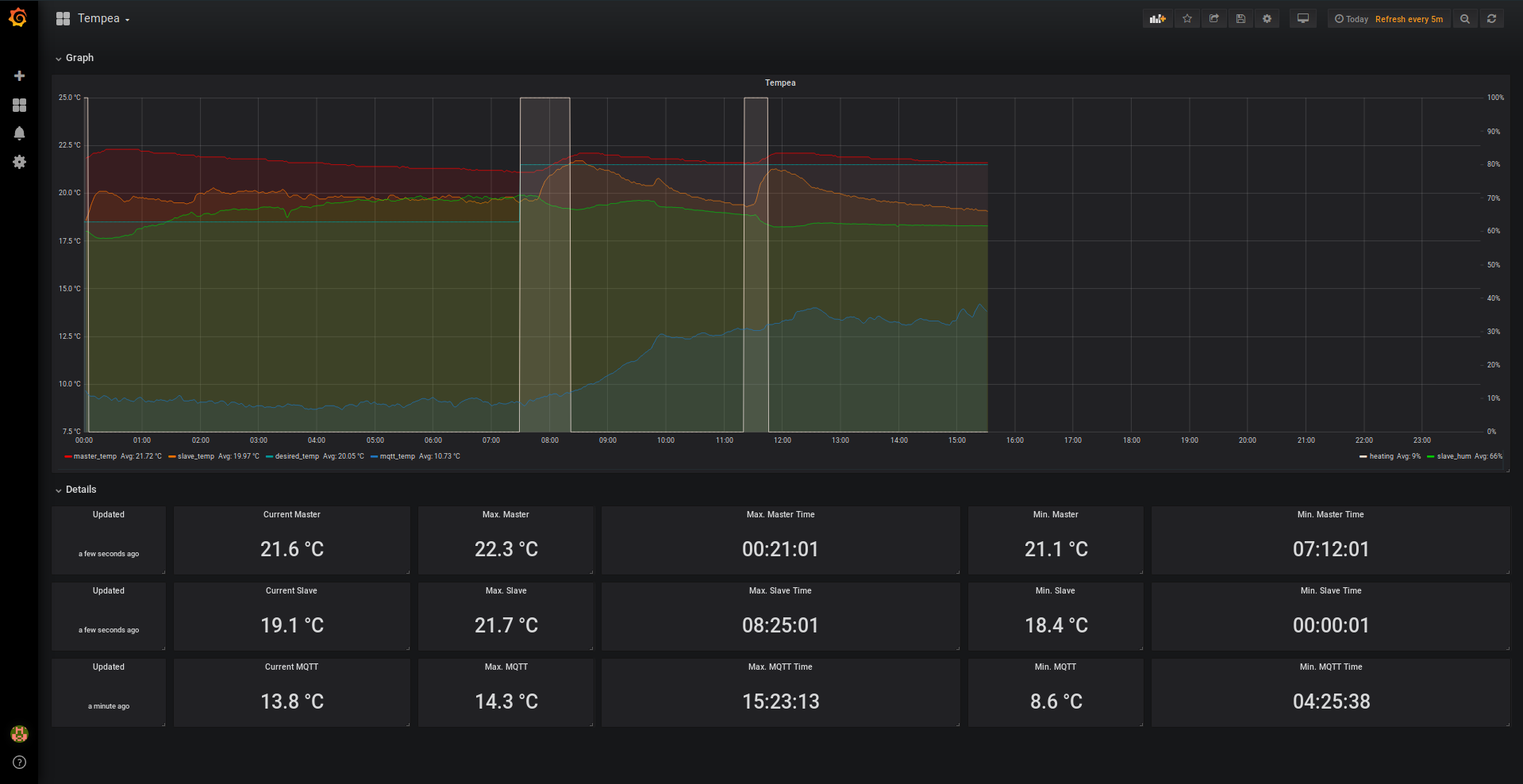The thermostat in our flat was pretty basic, so I decided to build my own one based on a Raspberry Pi, Docker, InfluxDB, node.js, a small PCB with a relay to control a gas boiler and a temperature sensor.
Grafana is used to plot temperature and heating period graphs.
After some research I stumbled over the great idea to use Google Calender to set a desired temperature. This reduced the complexity of the node application drastically and made it obsolete to expose the Raspberry Pi to the internet for remote management.
-
Get the latest lite version of raspbian from the official download page
-
Unzip the image
$ unzip 2018-11-13-raspbian-stretch-lite.zip
-
Insert your sd card into your PC
-
Run the following command to find out the name of your sd card
$ dmesg
- Flash the previously downloaded image using dd (may requires root permissions) to your sd card
# dd if=/home/eiabea/2018-11-13-raspbian-stretch-lite.img of=/dev/mmcblk0 bs=4M && sync
-
Wait until the command has finished successfully
-
Remove and reinsert your sd card (to initialize your sd card again)
- To set a static ip address open up the etc/network/interfaces file on your sd card and paste the following content (may requires root permissions)
# interfaces(5) file used by ifup(8) and ifdown(8)
# Please note that this file is written to be used with dhcpcd
# For static IP, consult /etc/dhcpcd.conf and 'man dhcpcd.conf'
# Include files from /etc/network/interfaces.d:
source-directory /etc/network/interfaces.d
auto lo
iface lo inet loopback
iface eth0 inet manual
- Open up the etc/dhcpcd.conf file and add the following content at the end of the file. Edit all values according to your network (may requires root permissions)
interface eth0
static ip_address=192.168.0.8/24
static routers=192.168.0.1
static domain_name_servers=192.168.0.1 8.8.8.8 4.2.2.1
- To set a static ip address open up the etc/network/interfaces file on your sd card and paste the following content (may requires root permissions)
# interfaces(5) file used by ifup(8) and ifdown(8)
# Please note that this file is written to be used with dhcpcd
# For static IP, consult /etc/dhcpcd.conf and 'man dhcpcd.conf'
# Include files from /etc/network/interfaces.d:
source-directory /etc/network/interfaces.d
auto lo
iface lo inet loopback
allow-hotplug wlan0
iface wlan0 inet manual
wpa-conf /etc/wpa_supplicant/wpa_supplicant.conf
- Open up the etc/dhcpcd.conf file and add the following content at the end of the file. Edit all values according to your network (may requires root permissions)
interface wlan0
static ip_address=192.168.0.8/24
static routers=192.168.0.1
static domain_name_servers=192.168.0.1 8.8.8.8 4.2.2.1
- Open up the etc/wpa_supplicant/wpa_supplicant.conf file and replace the content of the file with the following settings. Edit all values according to your network (may requires root permissions)
ctrl_interface=DIR=/var/run/wpa_supplicant GROUP=netdev
update_config=1
country=AT
network={
ssid="Your_wifi_ssid"
psk="Your_wifi_password"
}
- Create a blank file on the boot partition named ssh to enable ssh
$ touch ssh
-
Unmount and remove your sd card from your PC and insert it into your Raspberry Pi
-
Connect a ethernet cable between your router and the Raspberry Pi
-
Connect the power supply to boot up your Raspberry Pi
-
Login via ssh (username: pi, password: raspberry)
$ ssh [email protected]
- Update the system to the latest version
$ sudo apt update && sudo apt upgrade -y
- Run the following command to install docker
$ curl -sSL https://get.docker.com | sh
- Add the pi user to the docker group to start container as user
$ sudo usermod -aG docker pi
-
Log out and in again to gain access to docker
-
Verify the correct installation of docker
$ docker ps
- Install docker-compose
$ sudo apt install -y python-pip
$ sudo pip install docker-compose
- Verify the correct installation of docker-compose
$ docker-compose version
For running tempea the Raspberry Pi needs to be connected to some peripherals. In this case, a transistor driven relay is used to turn on a gas boiler and a digital temperature sensor with a one wire interface (DS18B20)
The schematics for this step can be found here and are created with Fritzing
The following images in combination with the schematics should make it easy to build up the circuit. Please note, that my relay had a different pinout than shown in the schematic. Check the data sheet of your relay to wire it up correctly. The relay should work as a closer, so if no power is supplied the outgoing pins must not be connected!
In order to get data from the DS18B20, the one wire interface of the Raspberry Pi has to be enabled. Open up /boot/config.txt and add the following lines at the end of the file
# OneWire
dtoverlay=w1-gpio,gpiopin=4,pullup=on
After rebooting, it should be able to see the connected sensor
$ ls /sys/bus/w1/devices/
10-00080278b776 w1_bus_master1
Take a note of the name (e.g. 10-00080278b776) of the slave, it will be needed in the following steps
-
Login at Google Developer Console
-
Create a new project (e.g.: tempea)
-
Click "Enable APIs and Services"
-
Search for "Google Calendar API" and enable it
-
In the side menu click on "IAM & admin" - "Service accounts"
-
Create a new service account (leave optional fields empty)
-
Create a new JSON key for your service account
Service json file (example)
{
"type": "service_account",
"project_id": "tempea",
"private_key_id": "bbc5f5b4422b7848d47cf2a4221c47ec1718f071",
"private_key": "-----BEGIN PRIVATE KEY-----\nMIIEDAI=\n-----END PRIVATE KEY-----\n",
"client_email": "[email protected]",
"client_id": "108968564556464390537",
"auth_uri": "https://accounts.google.com/o/oauth2/auth",
"token_uri": "https://oauth2.googleapis.com/token",
"auth_provider_x509_cert_url": "https://www.googleapis.com/oauth2/v1/certs",
"client_x509_cert_url": "https://www.googleapis.com/robot/v1/metadata/x509/tempea%40tempea.iam.gserviceaccount.com"
}
- Connect to the Raspberry Pi via ssh (username: pi, password: raspberry)
$ ssh [email protected]
- Create tempea directory
$ mkdir tempea
- Change into the tempea directory
$ cd tempea
Tempea can run in master and slave mode, to setup tempea as a slave jump to Setup Slave, otherwise continue reading
- Create secrets directory and copy/paste your google-service.json content into a new file called tempea-service.json
$ mkdir secrets
$ nano secrets/tempea-service.json
- Download the latest docker-compose.yml
$ wget -O docker-compose.yml https://raw.githubusercontent.com/eiabea/tempea-api/master/docker-compose.yml
- Download the latest tempea.env
$ wget -O tempea.env https://raw.githubusercontent.com/eiabea/tempea-api/master/tempea.env
- Open up the tempea.env file and change the values according to your needs/setup
# Logging
TEMPEA_LOG_LEVEL=10 # Verbosity (60=Fatal, 50=Error, 40=Warn, 30=Info, 20=Debug, 10=Trace)
# Calendar
TEMPEA_CALENDAR_PROVIDER=nextcloud # What type of calendar should be used (nextcloud, google)
# NextCloud
NEXTCLOUD_HOST=https://nextcloud.secret.at/remote.php/dav
NEXTCLOUD_USERNAME=eiabea
NEXTCLOUD_PASSWORD=secret
NEXTCLOUD_CALENDAR=tempea
# Google
GOOGLE_SERVICE_ACCOUNT_JSON=tempea-service.json # Name of the google service json file
[email protected] # Email address of your service account
# Modules
ROUTING_MODULE_HOST=0.0.0.0 # Host option of the node application
ROUTING_MODULE_PORT=3000 # Port definition
# Database
# Influx
INFLUX_HOST=influx
INFLUX_PORT=8086
INFLUX_DB=temp
INFLUX_MQTT_SERIES=mqtt_consumer
INFLUX_MQTT_TOPIC=esp_temp
# Hardware
# Temperature
SENSOR_ID=10-00080278b776 # Address of your OneWire sensor noted in the "OneWire"-section
# Relay
RELAY_GPIO_PIN=17 # GPIO pin of the relay (17 would mean physical pin 11)
# Slave
SLAVE_ENABLED=true # Enable/Disable slave feature
SLAVE_HOST=192.168.0.7 # Host of the slave
SLAVE_PORT=3000 # Port of the slave
SLAVE_ENDPOINT=/v1/status # Endpoint of the slave to get data from
# Celius (float)
MAX_TEMP=25 # Maximal temperature accepted
MIN_TEMP=15 # Minimal temperature accepted
OVERSHOOT_TEMP=0.5 # How much degrees should be "overheated"
# Minutes
FETCHING_INTERVAL=1 # How often should the calendar be checked
- Download the latest telegraf.conf
$ wget https://raw.githubusercontent.com/eiabea/tempea-api/master/telegraf.conf
- Download the latest tempea.env
$ wget -O tempea.env https://raw.githubusercontent.com/eiabea/tempea-api/master/tempea.env
- Open up the tempea.env file and change the environment section of the tempea service according to your needs/setup
# Tempea
TEMPEA_SLAVE=true # Run tempea in slave mode
# Modules
ROUTING_MODULE_HOST=0.0.0.0 # Host option of the node application
ROUTING_MODULE_PORT=3000 # Port definition
# Hardware
SENSOR_ID=10-00080278b776 # Address of your OneWire sensor noted in the "OneWire"-section
-
Login to your Google Calendar
-
Add the calendar of your service account (e.g.: [email protected])
-
Create a new event in this calendar with the desired temperature in the summary (e.g.: 21.5)
- Create more events in the same manner in order to set different temperatures on different dates/time. Keep in mind, that all days should be covered by a specific event, otherwise tempea will fallback to the MIN_TEMP for this period.
-
Login to your NextCloud
-
Make sure you have the NextCloud Calendar App installed on your instance
-
Create a new calendar called tempea
-
Create a new event in this calendar with the desired temperature in the summary (e.g.: 21.5)
-
Create more events in the same manner in order to set different temperatures on different dates/time. Keep in mind, that all days should be covered by a specific event, otherwise tempea will fallback to the MIN_TEMP for this period.
-
Open up the tempea.env file and change the values according to your needs/setup
Tempea can be started by simply run the following command in the project directory
$ docker-compose up -d
This command starts all necessary containers in background
In order to see the logs run
$ docker-compose logs -f
Example output:
tempea_1 | > [email protected] start /src
tempea_1 | > node index.js | ${NODE_PATH:-node_modules}/.bin/bunyan -o short -l 30
tempea_1 |
tempea_1 | 13:46:38.340Z INFO tempea: Creating cache controller (controller=cache)
tempea_1 | 13:46:38.349Z INFO tempea: Creating influx client (controller=database)
influx_1 | ts=2019-01-20T13:46:38.484164Z lvl=info msg="Executing query" log_id=0D6rhs5G000 service=query query="CREATE DATABASE temp"
influx_1 | [httpd] 172.19.0.3 - - [20/Jan/2019:13:46:38 +0000] "POST /query HTTP/1.1" 200 57 "-" "node-superagent/3.8.3" cf5a2162-1cb9-11e9-8018-0242ac130002 6017
tempea_1 | 13:46:38.611Z INFO tempea: Initializing routing module
tempea_1 | 13:46:38.651Z INFO tempea: Starting Backend on port 3000
tempea_1 | 13:46:38.678Z INFO tempea: Starting cron job (controller=schedule)
tempea_1 | 13:46:38.885Z INFO tempea: Backend listening on port 3000
tempea_1 | 13:47:01.658Z INFO tempea: Room temperature high enough, disabling heating (controller=heat, currentTemp=19.4, desiredTemp=18, overshoot=0.5)
In order to prevent data/configuration loss the only file which is needed to be updated for non-major releases is the docker-compose.yml
$ wget -O docker-compose.yml https://raw.githubusercontent.com/eiabea/tempea-api/master/docker-compose.yml
Pull, stop, remove and start the containers
docker-compose pull
docker-compose stop
docker-compose rm -f
docker-compose up -d
Grafana can be used to visualize the data stored by tempea into the InfluxDB. The Raspberry Pi is potent enough to handle both services locally.
In order to access Grafana open up a browser and enter
http://192.168.0.8:3001
The login credentials are
username: admin
password: admin
Add a new data source with the following parameters
Name: tempea
Type: InfluxDB
URL: http://influx:8086
Database: temp
Import the tempea dashboard by uploading the Tempea-Dashboard.json from the grafana directory of this project
Select the newly created tempea data source and click Import
- Mount the home directory of your Pi on your PC
$ mkdir raspberry
$ sshfs [email protected]:/home/pi raspberry
- Clone the project
$ cd raspberry
$ git clone https://github.com/eiabea/tempea-api.git
- Change into the project directory and create the secrets folder
$ cd tempea-api
$ mkdir secrets
-
Copy the secrets json file from Google into the secrets directory and name it tempea-service.json Obtaining Google Calendar Service JSON
-
Connect to the Raspberry Pi via ssh (username: pi, password: raspberry)
$ ssh [email protected]
- Change to the project directory
$ cd tempea-api
- Start tempea in development mode
$ docker-compose -f docker-compose.yml -f docker-compose-dev.yml up
- Make sure you have at least NodeJS v12.18.3 installed
$ node -v
v12.18.3
- Clone the project on your machine
$ git clone https://github.com/eiabea/tempea-api.git
- Change to the project directory and install all npm packages
$ cd tempea-api
$ npm install
- Run the tests with the following command
$ npm test
Every help is appreciated, take a look at the Contributing file.
